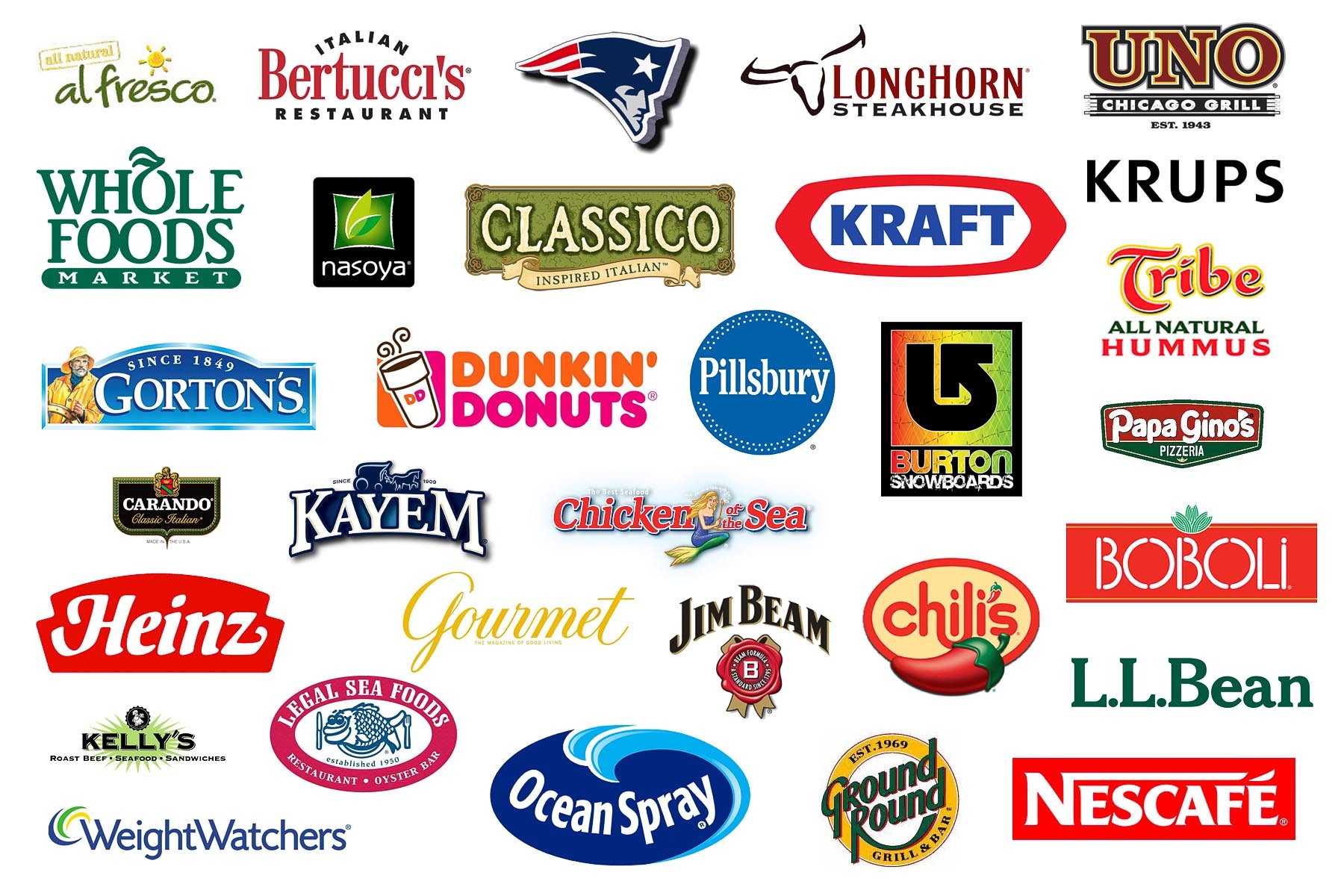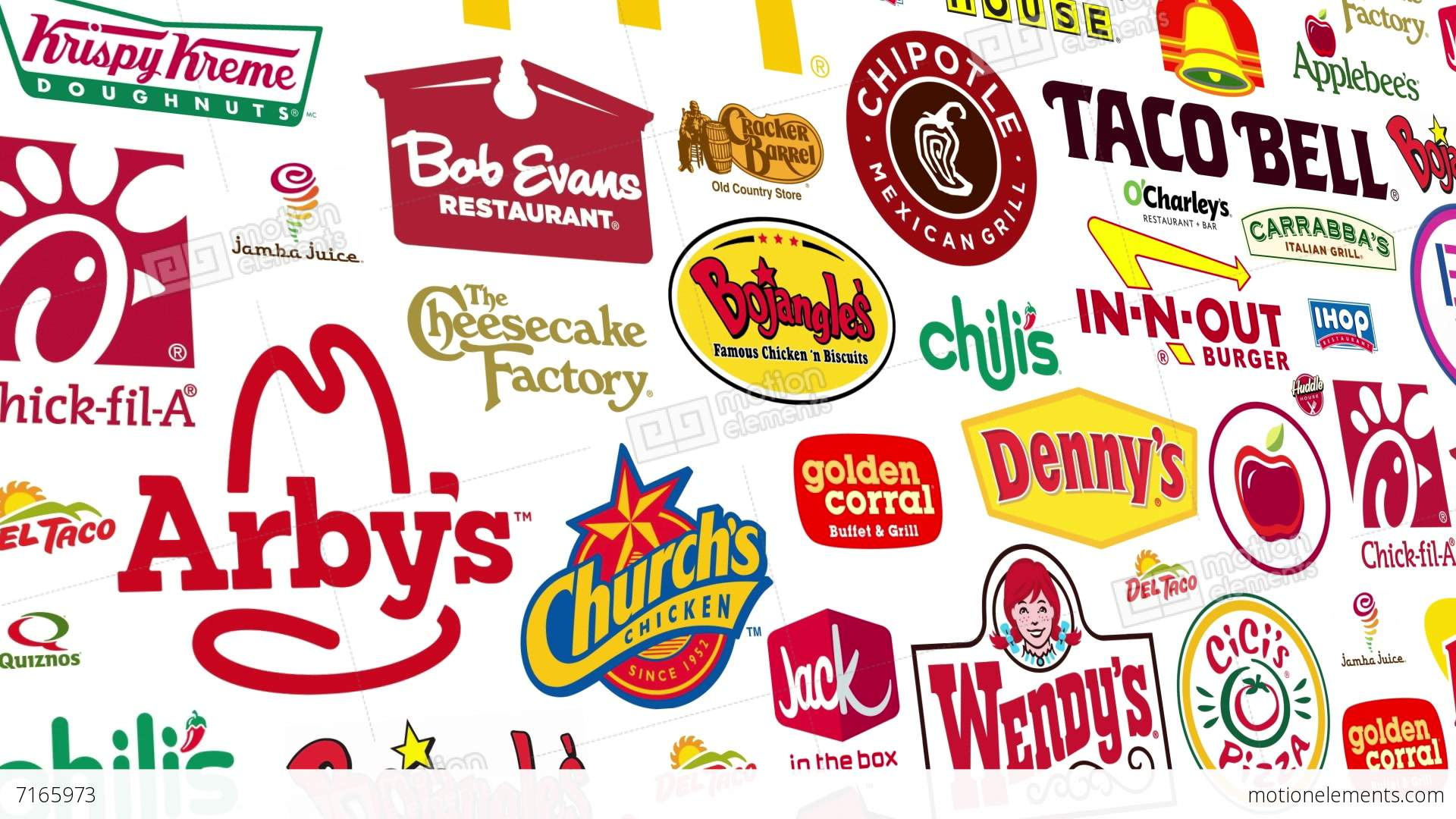Food brands and logos are the visual ambassadors of the culinary world, shaping our perceptions, influencing our choices, and creating lasting impressions. They are the emblems of our favorite flavors, the symbols of our dining experiences, and the storytellers of our food culture.
From the iconic golden arches of McDonald’s to the elegant script of Coca-Cola, food brands and logos have evolved over time, reflecting the changing tastes, values, and technologies of our society. They have become an integral part of our visual landscape, instantly recognizable and deeply embedded in our collective consciousness.
Overview of Food Brands and Logos

In the fiercely competitive food industry, food brands and logos play a pivotal role in capturing consumer attention, building brand loyalty, and driving sales. They serve as visual representations of a company’s identity, values, and product offerings.
Brand recognition is crucial for establishing a strong brand presence. A recognizable logo and brand name help consumers identify and differentiate a product from its competitors. This recognition builds trust and familiarity, making consumers more likely to choose the brand over others.
Brand Loyalty
Effective branding fosters brand loyalty, which encourages customers to repeatedly purchase a product over time. When consumers have a positive experience with a brand, they develop an emotional connection that influences their future purchasing decisions. Loyalty programs, personalized marketing, and consistent brand messaging can reinforce this bond.
Brand Differentiation
Brand differentiation is essential for standing out in the crowded marketplace. A unique and memorable logo and brand identity help a company differentiate its products from those of competitors. This differentiation can be achieved through distinctive packaging, innovative product design, or targeted marketing campaigns that highlight the brand’s unique value proposition.
Historical Evolution of Food Brands and Logos

The evolution of food brands and logos mirrors the changing social, cultural, and technological landscape. From humble beginnings to modern design, brands have adapted to meet the needs and preferences of consumers.
Early Packaging and Branding
Early food packaging focused primarily on preserving and transporting goods. Labels were simple, often featuring the product name and basic information. As brands emerged, they began using logos to differentiate their products and establish brand identity.
Industrial Revolution and Mass Production
The Industrial Revolution brought about mass production, leading to increased competition and the need for brands to stand out. Logos became more elaborate, incorporating illustrations and typography to create memorable and recognizable symbols.
Modern Design and Social Media
In the 20th and 21st centuries, food brands embraced modern design principles, using bold colors, clean lines, and minimalist aesthetics. The rise of social media has further influenced brand design, as logos need to be visually appealing and adaptable to different platforms.
Iconic Food Brands and Logos
- Coca-Cola: The iconic red and white logo has remained virtually unchanged since its inception in 1886.
- McDonald’s: The golden arches have become synonymous with fast food and are recognized worldwide.
- Campbell’s Soup: The red and white can featuring the “Campbell’s Kids” has been an American icon for over a century.
Design Principles for Food Brands and Logos
Food brands and logos are designed to entice consumers and create a lasting impression. To achieve this, they adhere to specific design principles that enhance their effectiveness. These principles encompass the use of color, typography, imagery, and symbolism, each playing a crucial role in shaping the brand’s identity.
Color
Color is a powerful tool in brand design, as it evokes emotions and conveys messages. Warm colors like red and orange stimulate appetite, while cool colors like blue and green suggest freshness and health. Brands such as McDonald’s and Coca-Cola have successfully utilized vibrant colors to create iconic logos that are instantly recognizable.
Typography
Typography is another essential element in food branding. The choice of font, size, and style can convey the brand’s personality and tone. Serif fonts, with their elegant strokes, lend a sense of tradition, while sans-serif fonts, with their clean lines, exude modernity.
Brands like Kellogg’s and Hershey’s have effectively used typography to create logos that are both visually appealing and memorable.
Imagery
Imagery plays a significant role in food branding, as it allows brands to connect with consumers on a visual level. Images of delicious food, such as juicy burgers or mouthwatering desserts, can stimulate cravings and create a desire for the product.
Brands like KFC and Burger King have mastered the use of mouthwatering imagery in their logos and advertising campaigns.
Symbolism
Symbolism is another powerful design principle in food branding. Symbols, such as animals, plants, or objects, can convey hidden meanings and evoke emotions. For example, the golden arches of McDonald’s symbolize a welcoming and inviting atmosphere, while the green apple of Applebee’s represents freshness and health.
Brands that effectively utilize symbolism create logos that are not only visually appealing but also rich in meaning.
Case Studies of Successful Food Brands and Logos
To understand the principles and practices behind successful food brands and logos, it is essential to examine real-world examples that have achieved widespread recognition and consumer loyalty. By conducting case studies of such brands, we can identify commonalities, best practices, and factors contributing to their success.
The following case studies will analyze the design, marketing strategies, and consumer perception of several renowned food brands, providing insights into the effective use of branding and logos in the food industry.
Coca-Cola
Coca-Cola is a globally recognized beverage brand that has maintained its dominance in the market for over a century. The iconic red and white logo, featuring the Spencerian script, has become synonymous with refreshment and happiness. The brand’s consistent marketing campaigns and emphasis on nostalgia have played a significant role in building a strong emotional connection with consumers.
- Design:The Coca-Cola logo is simple, memorable, and instantly recognizable. The red and white color scheme evokes a sense of refreshment and excitement, while the Spencerian script adds a touch of elegance and tradition.
- Marketing:Coca-Cola has invested heavily in advertising and marketing campaigns, creating memorable slogans and associating the brand with positive emotions. The “Share a Coke” campaign, which featured personalized bottles with consumer names, was particularly successful in fostering a sense of community and belonging.
- Consumer Perception:Coca-Cola is perceived as a trusted and reliable brand, associated with happiness, nostalgia, and refreshment. Consumers have a strong emotional attachment to the brand and often view it as a symbol of American culture.
Emerging Trends in Food Brands and Logos
The food industry is constantly evolving, and so are the brands and logos that represent it. In recent years, we’ve seen a number of emerging trends in food brand and logo design, including the use of new technologies, a focus on sustainability, and an emphasis on health consciousness.
Use of New Technologies
New technologies are playing a major role in the evolution of food brands and logos. Augmented reality (AR) and artificial intelligence (AI) are two of the most popular technologies being used today. AR allows consumers to interact with brands in new and exciting ways, while AI can be used to create personalized experiences and recommendations.
Sustainability
Sustainability is another major trend in food brand and logo design. Consumers are increasingly interested in buying products from companies that are committed to environmental and social responsibility. As a result, we’re seeing more and more food brands using eco-friendly packaging and promoting sustainable practices.
Health Consciousness
Health consciousness is another important trend in food brand and logo design. Consumers are increasingly looking for healthy and nutritious food options. As a result, we’re seeing more and more food brands using logos that emphasize the health benefits of their products.
Conclusion

In conclusion, the analysis of food brands and logos reveals several key findings that provide valuable insights into the future of branding in the food industry and offer practical recommendations for businesses seeking to create effective food brands and logos.
As the food industry continues to evolve, it is imperative for businesses to adapt their branding strategies to meet the changing demands of consumers. By embracing innovation, leveraging technology, and understanding the principles of effective food brand and logo design, businesses can create brands that resonate with consumers, drive sales, and build lasting relationships.
Insights into the Future of Food Brands and Logos
The future of food brands and logos is characterized by several key trends:
- Increased personalization:Consumers are increasingly seeking personalized experiences, and this trend is expected to continue in the food industry. Food brands will need to find ways to tailor their products and marketing to individual consumers.
- Focus on sustainability:Consumers are becoming more aware of the environmental and social impact of their food choices. Food brands will need to demonstrate their commitment to sustainability through their branding and packaging.
- Rise of e-commerce:The growth of e-commerce is changing the way consumers purchase food. Food brands will need to adapt their branding and packaging to meet the needs of online shoppers.
Recommendations for Creating Effective Food Brands and Logos
Businesses looking to create effective food brands and logos should consider the following recommendations:
- Define your brand identity:Clearly define your brand’s values, mission, and target audience. This will serve as the foundation for your branding and logo design.
- Create a memorable logo:Your logo is the visual representation of your brand. It should be memorable, relevant, and scalable across different platforms.
- Use consistent branding:Ensure consistency in all aspects of your branding, from your logo to your packaging and marketing materials.
- Be adaptable:As the food industry evolves, so too must your branding. Be prepared to adapt your branding and logo to meet the changing needs of consumers.
Question & Answer Hub
What is the importance of food brands and logos?
Food brands and logos are essential for creating brand recognition, building customer loyalty, and differentiating products in the competitive food industry.
How have food brands and logos evolved over time?
Food brands and logos have evolved from simple packaging labels to sophisticated visual identities, reflecting changing consumer preferences, technological advancements, and cultural influences.
What are the key design principles for effective food brands and logos?
Effective food brands and logos utilize color, typography, imagery, and symbolism to create a memorable and recognizable visual identity that aligns with the brand’s values and target audience.
What are some commonalities among successful food brands and logos?
Successful food brands and logos often share characteristics such as simplicity, memorability, relevance to the brand’s identity, and consistency across all marketing channels.
How can businesses create effective food brands and logos?
Businesses can create effective food brands and logos by understanding their target audience, defining their brand values, and implementing sound design principles that resonate with consumers.
